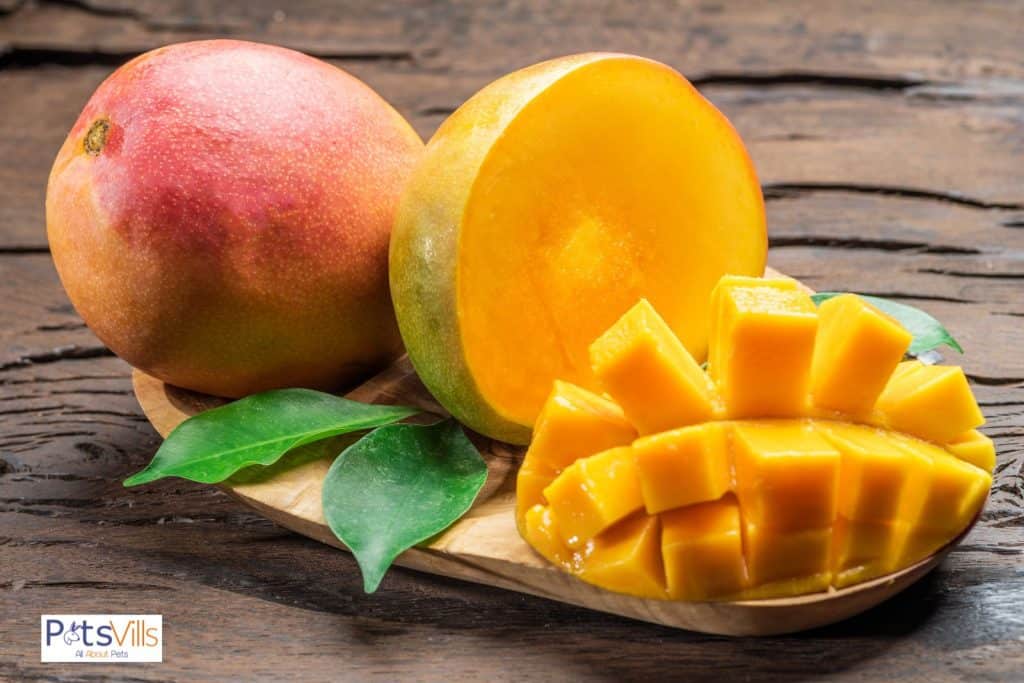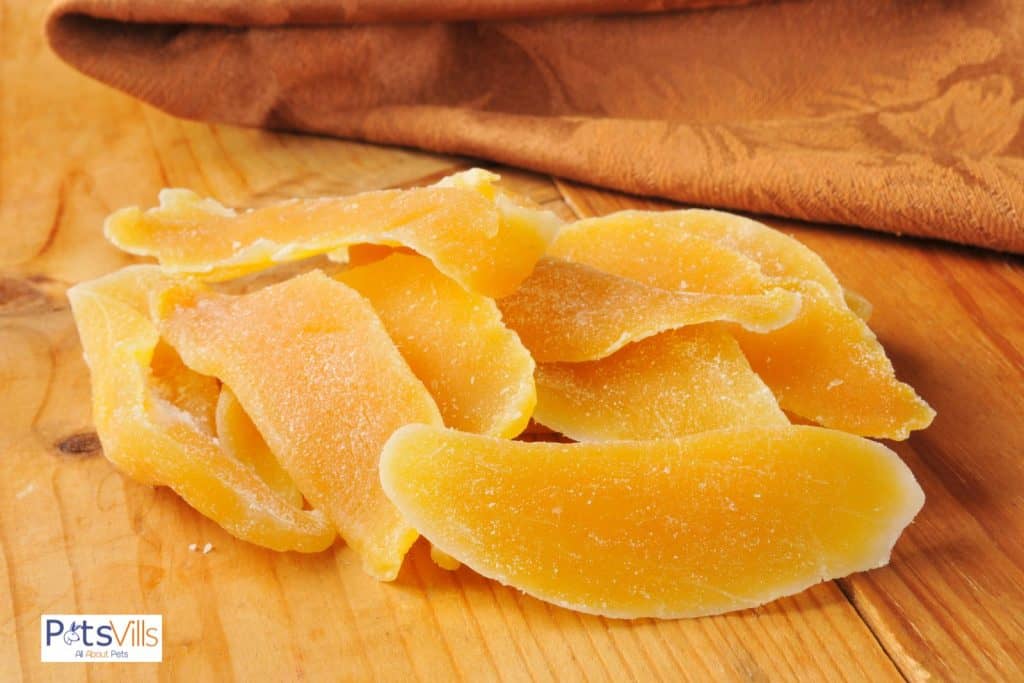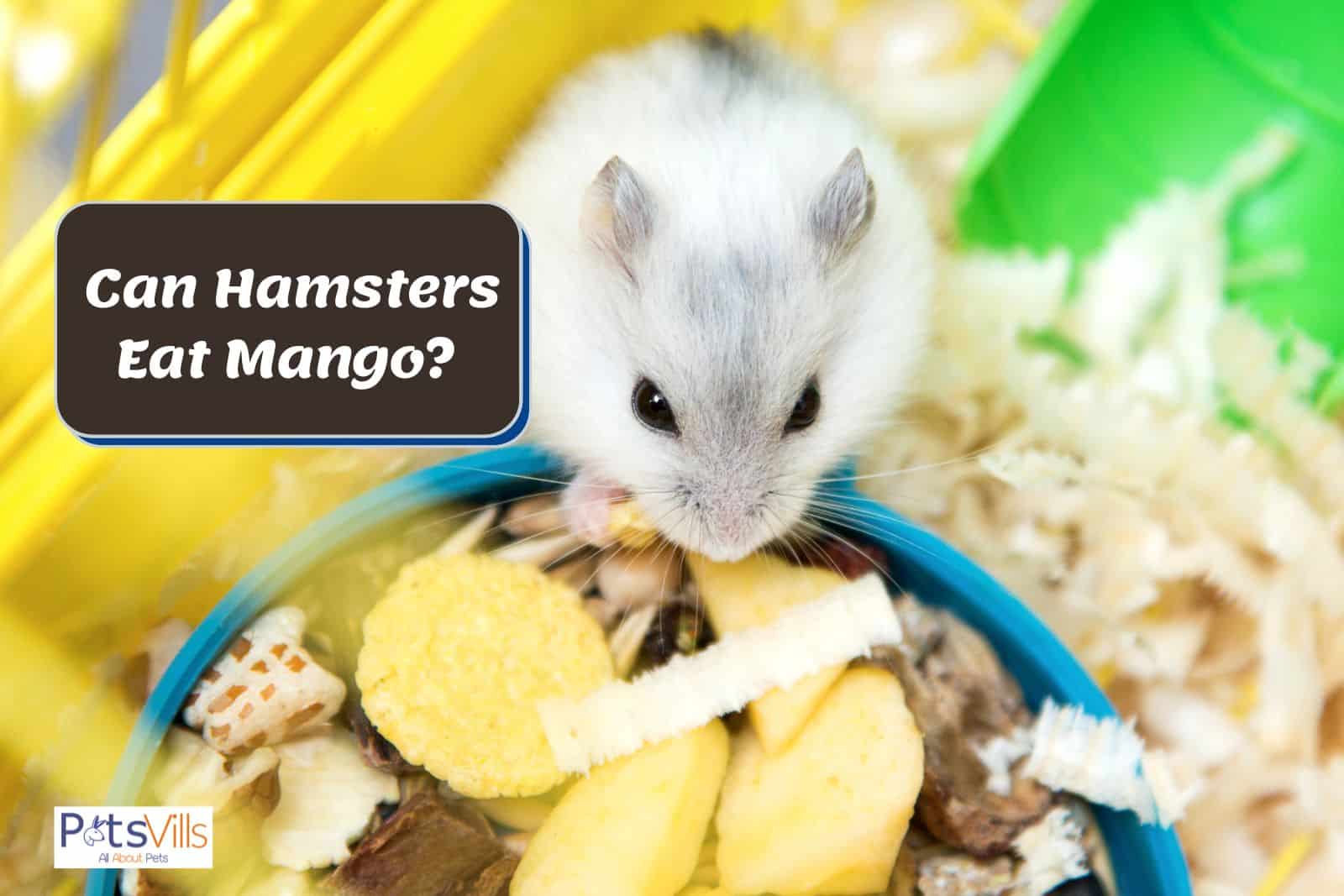As a hamster parent, I’ve often heard that whatever a hamster eats in the wild is perfectly safe for them as pets. This got me wondering can hamsters eat mango?
Fortunately, I’ve done the research, and it turns out that, yes, they can! They love the taste of mango, but you should be wary of the amounts served.
Let’s delve into mango’s benefits, risks, and feeding tips.
Table of Contents
Key Takeaways
- Hamsters love to eat mango, and it’s safe for them.
- Due to the high sugar content, mango should only be fed in moderation
- Larger hamsters, like Syrian hamsters can have more mango than dwarf ones.
READ MORE: What Hamster Food is Best?
Is it Safe For Hamsters To Eat Mango?

Yes, it’s safe for hamsters to eat a piece of mango. This fruit doesn’t contain toxins, and hamsters will enjoy eating it because of its sweet taste.
However, due to their high sugar content, they can become unsafe for them.
Hamsters that consume too much sugar will develop health issues such as diabetes and obesity.
If they eat too much mango on a single occasion, this fruit can cause the hamster to become bloated and have diarrhea.
Because hamsters tend to store food in their cheek pouches, stored sugary mangoes can cause serious oral health problems.
Secondly, the mango skin is tough and can be a choking hazard. So it should never be offered to your pet.
To make mango safe for your pet hamsters, only feed them the fruit in moderation. This means a sliver of mango once or twice or week.
Health Benefits of Mango for Hamsters
Fresh foods are essential as part of your hamster food. Mango is packed with nutrients that your hamster can benefit a lot from. It’s a good source of antioxidants, vitamins, and minerals. [1]
One cup (165 grams) of sliced mango provides the following:
- Calories:99
- Protein:1.4 grams
- Carbs:24.7 grams
- Fat:0.6 grams
- Dietary fiber:2.6 grams
- Vitamin C:67% of the Reference Daily Intake (RDI)
- Copper:20% of the RDI
- Folate:18% of the RDI
- Vitamin B6:11.6% of the RDI
- Vitamin A:10% of the RDI
- Vitamin E:9.7% of the RDI
- Vitamin B5:6.5% of the RDI
- Vitamin K:6% of the RDI
- Niacin:7% of the RDI
- Potassium:6% of the RDI
- Riboflavin:5% of the RDI
- Manganese:4.5% of the RDI
- Thiamine:4% of the RDI
- Magnesium:4% of the RDI
The above data is according to the USDA.
Below are some of what the hamster can benefit from eating mango:
1-High in Antioxidants
Antioxidants are important to the health of hamsters. This protects the cells from free radicals, which may play a role in heart disease, cancer, and other diseases.
Free radicals are molecules produced when the body breaks down food or when the hamsters are exposed to smoke from cigarettes.
2-Helps Boost Immunity
Mangos are one of the highest food sources of vitamin C. This vitamin is important to the immune system.
Vitamin C in the mango will aid in boosting your hamster’s immunity,
]Additionally, vitamin C also plays an important role in muscle, tendon, and bone growth.
3-Promotes Healthy Digestive System
Mango is a good source of dietary fiber. Fiber is important to the digestive system as it helps promote regular bowel movement and prevent constipation.
4-Vitamin B
Vitamin B promotes eye health and maintains your pet hamster’s cholesterol levels.
5-Vitamin B9
Mango has substantial amounts of Vitamin B9, which is great for red blood cell formation. This results in the proper functioning of the immune system.
Now that we’ve established the benefits of mango in your hamster’s food bowl, here is how you should feed it.
How To Feed Mango To Hamsters?

It is a common misconception that hamsters cannot eat mango. This is not true! Mangoes are very nutritious for hamsters and can be fed to them in small amounts daily.
To feed your hamster a mango, peel off the skin before cutting it. It may seem strange, but this works better than eating it without mango peels!
Then cut up the mango into small pieces so your hamster can eat it easily.
Since a mango is too big for your furry friend to eat, you’ll want to cut a small piece of the fresh fruit to feed them. And, of course, do not give your hammy the mango seed. It’s too big and too slippery.
You should also ensure that you give your hamsters a little at a time because they can become sick if they eat too much!
Another option is to mix mango fruit with their regular food of quality commercial pellets. This will give their food an extra boost of nutrition. Slice off a small amount of mango and dice up the mango into bits and pieces. Then mix it in with the food and feed them to the hamsters.
Remember – only give them small amounts of mangos each day – but how much is too much?
How Many Mangoes Can You Feed a Hamster?
Mangoes are relatively safe for hamsters to eat since they contain no toxins. But due to its high sugar, mango should only be offered to them in moderation.
Baby hamsters should not be fed any mango. Feeding them mango, even a teaspoon of mango could cause them to choke on it. It’s best not to feed them until they are three weeks old.
For adult hamsters, you should only feed them in moderation. Due to the fruit’s sweet taste, the hamsters will ask for more.
Syrian hamsters and Roborovski hamsters can have more than the other breeds (dwarf hamsters and Chinese hamsters) because they are the largest breed.
If you brought home a hamster that’s an adult and you’re unsure if it ever had any fruits, it’s best to avoid mango. Instead, offer them something lower in sugar, such as a small apple or pear.
Once they start eating fruit and get used to it, you can try introducing mango.
Remember, you should monitor them for the first 12 hours when introducing mango or any new food. Not all hamsters are the same, so you’ll need to watch if mango causes them any issues.
Look out for things such as diarrhea, upset stomach, or discomfort. If you notice any of these, don’t give them more mango. Instead, try to give them other foods.
How Often Can Hamsters Eat Mango?
Hamsters can’t handle a lot of sugar due to their small size. Therefore, you should only give sweet fruits to them once or twice a week.
Rotating fresh mango with other fruits throughout the week is also a good idea. That way, they won’t get bored with the same food everything.
Also, your hamster will get additional nutrition that mango doesn’t have.
Can Baby Hamster Eat Mango?
Baby hamsters under three weeks should not be given any mango or solid food. They are still nursing at this age, and their digestive system isn’t developed.
After the age of 3 weeks, you can start to introduce them to fruits. It’s a good idea to feed them other fruits that are low in sugar. These include apples, pears, and most berries. After a while, you can start to feed them mangoes.
Can hamsters eat dried mango?

Yes, hamsters can eat dried mango, but only those with no sugar or preservatives. However, mangoes will naturally contain a bit of sugar in them. Therefore, whether the dried mango is unsweetened or has sugars added, only offer them a tiny sliver.
Can mango make hamsters sick?
Riped mango has a high content of sugar. This will lead to health issues such as obesity and diabetes for the hamsters.
In the long run, it will shorten the hamster’s life expectancy. The problems only occur when mango is fed to them excessively.
Therefore, only feed mango to the hamsters in moderation.
Can Hamsters Have Mango Juice
No hamsters can not have mango juice. On a hot summer afternoon, you might be tempted to share a few drops of juice with your pet, but this could be risky.
Juices contain added sugars and preservatives, which could be fatal to your little one.
Also, avoid frozen mango, mango ice cream, and mango pies.
Here are some other things you can try feeding your hamster:
3- Other Fruits That Hamsters Can Eat
The best fruits to give them are similar to what they might eat in the wild. Below are some of the fruits you can feed the hamsters:
Apples
Hamsters eat apple make an excellent treat for hamsters due to their high nutrition. Make sure to remove the stem and seeds before feeding them. These things are a choking hazard for hamsters.
Pears
This fruit is a seasonal fruit that is only available during the summer months. Pears are rich in folate, vitamin, copper, and potassium. They are also a good source of antioxidants. Like other fruits, give pears to the hamsters as treats. Once or twice a week is sufficient for them.
Apricot
Apricots are an excellent vitamin A source for healthy skin and eyesight. Apricots also provide calcium, iron, potassium, and dietary fiber.
CHECK: Do Hamsters Eat Raisins?
FAQs
Can Hamsters eat dandelion greens?
Yes, hamsters can eat dandelion greens and other leafy green vegetables.
Can Hamsters eat kidney beans?
No, it would help if you did not feed your hamster kidney beans. These are toxic to hamsters.
Conclusion
Can hamsters eat mango? Yes, hammies love this juicy fruit but should only have it in moderate amounts.
Ensure your pet has a balanced diet and fruits eaten as treats, and they will live long healthy lives. [3]

So, did you ever feed mango to your hamster? Let us know in the comments section!
Sources
- 1. Fowomola M. some nutrients and antinutrients contents of mango (Magnifera indica) seed. African Journal of Food Science. 2010;4(8):472-476. https://academicjournals.org/article/article1380729035_Fowomola.pdf
- 2. USDA. USDA. Usda.gov. Published December 31, 1999. https://www.usda.gov/
- 3. Cooperman JM, Waisman HA, Elvehjem CA. Nutrition of the Golden Hamster. Experimental Biology and Medicine. 1943;52(3):250-254. doi:10.3181/00379727-52-14107
Alina Hartley is a small-town girl with a ginormous love of bearded dragons. It all started with Winchester, a baby bearded who was abandoned at the shelter by his former owners because of a birth defect that caused one front leg to be shorter than the other. Alina originally went to the shelter looking for a guinea pig, but one look at Winchester and it was love at first sight. From that day on, Alina has dedicated her life to learning everything she can about bearded dragons. She loves helping new beardie parents start their incredible journey with these magnificent reptiles.
Follow her on:
LINKEDIN
TWITTER.
Read her latest articles HERE
Learn more about her HERE.


